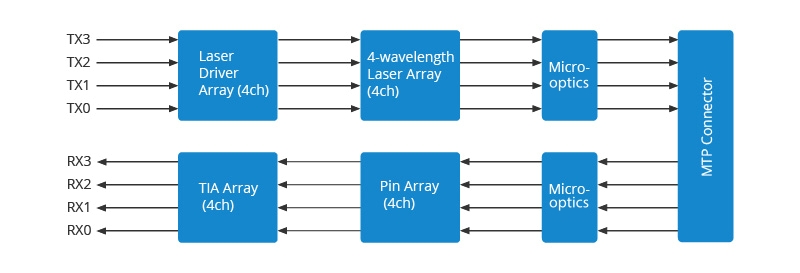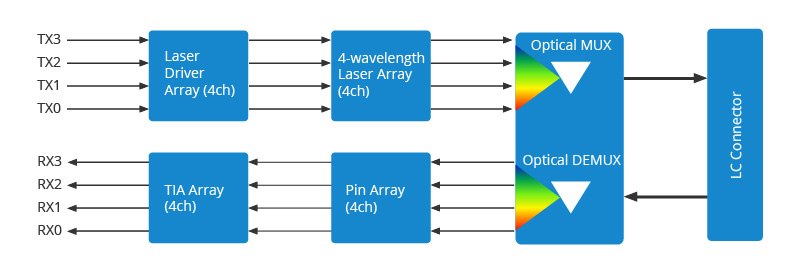40G QSFP+ MTP vs 40G QSFP+ LC Transceivers
Since 40 Gigabit Ethernet has been deployed in most data centers, a variety of network devices designed for 40GbE links are available on the market. 40G transceivers is bound to be an indispensable component. Generally speaking, there are two interfaces adopted by 40G QSFP+ transceivers—MTP/MPO and LC. Then QSFP+ MTP vs QSFP+ LC transceivers: what are their differences?
What Are 40G QSFP+ MTP and 40G QSFP+ LC Transceivers?
The connector type that attached to both ends of the patch cords is decided by the interface of the 40G transceivers. Normally speaking, 40G QSFP+ transceivers for short-transmission distance are equipped with MTP interfaces, and LC interfaces are employed for long-transmission distance. The specific modules and some exceptions will be meticulously introduced in the second part.
40G QSFP+ MTP modules are QSFP+ transceivers with MTP interfaces, which are collocated with MTP/MPO cables. MTP is an enhanced version of generic MPO (multi-fiber push-on), and they are called interchangeably. In most cases, we'll just use "MTP" for convenience. 40GbE QSFP+ MTP modules typically connect with 8 or 12 fibers MTP cables that are terminated with 12-fiber parallel (female) MTP connectors.

40G QSFP+ LC modules are QSFP+ transceivers with LC interfaces, which are armed with LC cables. 40GbE QSFP+ LC modules typically connect with 2-fiber duplex LC cables that are terminated with 2-fiber duplex LC connectors.

QSFP+ MTP vs QSFP+ LC Transceivers: What Are Their Differences?
Working Principle
40G QSFP+ MTP transceiver—On the transmit side, the transmitter converts parallel electrical input signals into parallel optical signals through the use of a laser array. Then the parallel optical signals are transmitted simultaneously through the MTP parallel cable. On the receive side, the receiver converts parallel optical input signals via a photodetector array into parallel electrical output signals. It's worthwhile to mention that MTP interfaced 40G QSFP+ transceivers can be used in 4x10G connectivity via an external 12-fiber parallel to 2-fiber duplex breakout cable.

40G QSFP+ LC transceiver—On the transmit side, 4-channel 10G serial data streams are passed to laser drivers. The laser drivers control directly modulated lasers (DML) with wavelengths. Then the output of the four DMLs is optically multiplexed to a fiber cable through an LC connector, combining as a 40G optical signal. On the receive side, the 40G optical signal is demultiplexed into 4 individual 10G channels with different wavelengths. Each wavelength light is collected by a PIN and then outputted as electric data after amplified by a TIA (transimpedance amplifier). Unlike 40G QSFP+ transceivers with MTP interfaces, 40G QSFP+ transceivers with LC interfaces cannot be split into 4x10G as they use 4 wavelengths on one pair of SMFs.

Single Mode vs Multimode QSFP+
Single mode fiber (SMF) has much tighter tolerances for optics used. The core is smaller and the laser wavelength is narrower, which means that SMF has the capability for higher bandwidth and much longer distances in transmission. 40G QSFP+ transceivers that have LC interfaces are typically used in data transmission over long distances via SMFs, except that 40GBASE-BiDi transmits data with an LC interface over short distances (100 m@OM3; 150 m@OM4) via multimode fiber (MMF).
MMF uses a much bigger core and usually uses a longer wavelength of light. Because of this, the optics used in MMF have a higher capability to gather light from the laser. 40G QSFP+ transceivers with MTP interfaces are generally deployed for short transmission via MMFs, except for 40GBASE-PLR4 and 40GBASE-PLRL4, they support long-distance transmission over SMFs.
The table below summarizes the cable type, the connector type, and the max. transmission distances of nine common QSFP+ types (Note: 40GBASE-UNIV can operate with both MMF and SMF).
| 40G Transceiver | Parallel MTP | Duplex LC | ||
|---|---|---|---|---|
| SMF | Type | Reach | Type | Reach |
| 40GBASE-PLRL4 | 1km or 1.4km | 40GBASE-LR4L | 2km | |
| 40GBASE-LR4 | 10km | |||
| 40GBASE-PLR4 | 10km | 40GBASE-ER4 | 40km | |
| 40GBASE-UNIV | 500m to 2km | |||
| MMF | 40GBASE-SR4 | 100m@OM3 150m@OM4 | 40GBASE-BiDi | 100m@OM3 150m@OM4 |
| 40GBASE-CSR4 | 300m@OM3 400m@OM4 | 40GBASE-UNIV | 150m@OM3/OM4 | |
QSFP+ MTP vs QSFP+ LC transceivers: What Are Their Matched Patch Cables?
Advanced switches, matched patch cords and transceiver modules are all indispensable in the 40G transmission network. Learn to select proper patch cords for 40G transceivers is still of great significance. Generally speaking, the selection of patch cords is influenced by two main factors: transmission distance and connector type.
The aforementioned nine transceivers are available in short or long 40G transmission, such as 40GBASE-SR4 (for short reach) and 40GBASE-LR4 (for long reach). MMF is suggested for 40G QSFP+ short transmission distance, while SMF is advisable for 40G QSFP.
For 40G QSFP+ MTP transceivers, the MTP cables can be either MTP trunk cables or MTP harness cables. The MTP trunk cable is a cable with two MTP connectors at both ends serving as a permanent link connecting the MTP interfaced modules to each other. An MTP trunk cable together with the 40G QSFP+ transceiver modules is used for 40G-40G connection. The MTP harness cable, also known as fanout cable or breakout cable, has a single MTP connector on one end and 4 LC duplex connectors on the other end. An 8-fiber MTP to LC duplex breakout cable with one 40G QSFP+ transceiver and four 10G SFP+ transceivers can achieve 40G-4x10G connection.
Unlike the previous 40G QSFP+ MTP module, 40G QSFP+ LC transceivers are applicable to 40G-40G connection only. The matching between transceivers and patch cords are listed below: 40GBASE-BiDi transceiver can transmit full-duplex 40Gbps traffic with OM3 or OM4 multimode LC duplex patch cords, 40GBASE-LR4/LR4L/ER4 are often accompanied with single mode LC duplex patch cords, and LC-interfaced 40GBASE-UNIV supports both SMF and MMF LC patch cords.
See the table below for detailed information of nine common QSFP+ modules' patch cords selection:
| Model | Application | Cable Type & Polish Type | Polarity (typically) |
|---|---|---|---|
| 40GBASE-SR4 40GBASE-CSR4 | 40G-40G | MTP-12 UPC MMF Female Trunk | Type B |
| 40G-4x10G | MTP-8 UPC to 8xLC MMF APC Female Harness | Type B | |
| 40GBASE-PLRL4 40GBASE-PLR4 | 40G-40G | MTP-12 APC SMF Female Trunk | Type B |
| 40G-4x10G | MTP-8 APC to 8xLC UPC SMF Female Harness | Type B | |
| 40GBASE-LR4 40GBASE-LR4L 40GBASE-ER4 | 40G-40G | LC UPC Duplex SMF Fiber Optic Patch Cable | N/A |
| 40GBASE-BiDi | 40G-40G | LC UPC Duplex MMF Fiber Optic Patch Cable | N/A |
| 40GBASE-LR4 40GBASE-LR4L 40GBASE-ER4 | 40G-40G | LC UPC Duplex SMF/MMF Fiber Optic Patch Cable | N/A |
Note: The polarity must be considered when selecting MTP cables for 40G QSFP+ MTP modules. There are three different MTP array patch cords defined in the TIA standard—Type A, Type B, and Type C used for the three different connectivity Methods A, B, and C respectively. For your reference, here offers another article that is informative and exhaustive about MPO polarity: Polarity and MTP Technology in 40/100G Transmission.
FAQs
There are MTP and MPO cables available in the market, what's the difference and how can I choose for 40G QSFP+ MTP?
MPO stands for "multi-fiber push on." While MTP is a brand name for MPO connectors manufactured by US Conec, which is incomplete compliance with MPO connectors. FYI, all MTPs are MPOs but not all MPOs are MTPs. Both MTP and MPO connectors are feasible solutions, but MTP is an enhanced version of MPO with minor price differences. Normally, MTP patch cords are recommended.
Can a 40GBASE-UNIV QSFP+ transceiver working on the wavelength of 850nm be used with OM1 patch cords?
The answer is yes, but not suggested. The transmission distance and quality would be limited by using OM1 with 40G QSFP+ transceivers. OM1 patch cords are normally suggested for 100Mbps and 1000Mbps transmission. In this case, the two optimized multimode fiber optic cables for short distance—OM3 and OM4 are more suitable.
You might be interested in
Email Address

-
PoE vs PoE+ vs PoE++ Switch: How to Choose?
Mar 16, 2023














